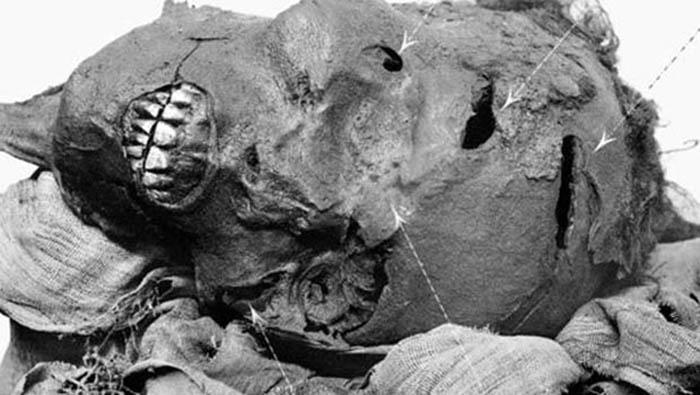Dynasty became stronger at Thebes around 1650 BC. About it’s founding and history is very little known. There are much more information about those rulers who fought at the end of the dynasty against the Hyksos.
Theban rulers were connected with other Hyksos (Crete, etc.) opponents and together they took action against them. Theben Dynasty was under the rule of Hyksos. After the situation in the country calmed down a bit, rulers took advantage of their connection with the people, and they started a great fight for the liberation of the country. Also in this fight, they took advantage of the weapons, which Hyksos brought with them.
Antef V, Rahotep, Sobekemsaf I, Djehuti, Mentuhotep VII, Nebirierau, Antef VI, Antef VII, Antef VIII.
Seqenenre II
Papyrus Sallier I contains text with Apophis message to pharaohs, where Apophis is trying to provoke a conflict with the independent Egyptian dynasty from Thebe. He is mocking pharaoh by saying to him that he cannot sleep due to the roaring of the hippos from Thebe.
There was a conflict in which the Seqenenra was killed as evidenced of that is his mummy, which researchers found in a hidden tomb in Deir el Bahri.



Mummy had a hole in the head. His wife, Queen Ahhotep was particularly celebrated during period of eighteen dynasties. From her grave was Ahmes’s war ax covered with golden leafs. She, prior to Jahmes coming to the throne, quell uprising by military intervention and in that, way she contributed to the establishment of order in the country.
Siamun, Seqenenre (Ta-aa) (around 1560.)
Kamose (1.555 – 1.550)
The most important original document from that period is Carnarvon Tablet where Kamose, Seqenenre’s son urges his council the Djadjat to begin the fight against the invaders. Lord Carnarvon found the tablet in 1908, while French archaeologists in 1935. found the transcript in Karnak. The second tablet was discovered in 1954. and it speaks of Kamose’s fight at Avaris. It is believed that he have been killed in the battle against the Hyksos.
Ahmes (gr. Ahmosis)
Kamose’s brother came on the throne too young and due to that, a truce was made which lasted for ten years. After that began struggle for the complete liberation of Egypt. Ahmes, a son of Abana and warrior Babe had a same name as Pharaoh and Admiral of an Egyptian army. He gave the most detailed description of the battles in his biography, which was carved in the tomb, in El Cabo.
It was written about cruel conflicts with Hyksos etc. It is possible that from these events comes Jewish story of the Exodus in the Egypt because Jewish slavery in the Egyptian sources was never mentioned. While Josephus Flavius wrote about Hyksos as Jews or people from which Jews were created. He also wrote about how he was searching for them when they left Egypt, because they took treasure that should be returned. At this time, Thebes grew into an important center and its necropolis on the west coast was promoted in to a royalty. Amon rises in the supreme divine of Egypt. See more: Ahmes I
